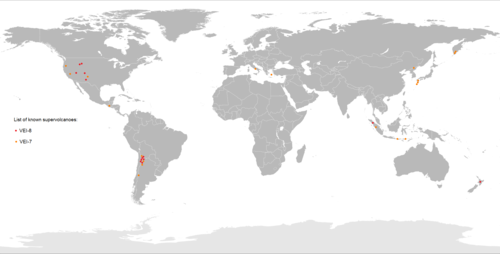Supervolcano
A supervolcano is a volcano that can make a volcanic eruption where the things being thrown out of the volcano have a volume bigger than 1,000 km3 (240 cu mi), which is a Volcanic Explosivity Index (VEI) of 8. If the definition is expanded, supervolcanoes also include volcanoes that have volcanic eruptions with a volume bigger than 100 km3 (24 cu mi), which is a Volcanic Explosivity Index (VEI) of 7. This is thousands of times bigger than most volcanic eruptions which happened a long time.[1] Supervolcanoes can occur when magma in the Earth rises into the crust from a hotspot, but can not break through the crust. More and more pressure builds up in a large and growing magma pool until the crust can no longer take the pressure.
Although there are not many Quaternary supervolcanoes, supervolcanic eruptions usually cover very big areas with lava and volcanic ash. They can also cause a long-lasting change to weather (such as causing a volcanic winter which can trigger a small ice age), enough to possibly make species extinct.

Terminology[change | change source]
The term "supervolcano" was first used in the BBC popular science television program Horizon in 2000 to mean eruptions of this type.[2][3]
Volcanologists (who study with volcanoes) and geologists do not say "supervolcanoes" in their scientific work. This is because the word can mean many different geothermal conditions. Since 2003, however, the term has been used by professionals when showing things to the public. The term megacaldera is sometimes used for calderas which are quite similar to supervolcanoes, such as the Blake River Megacaldera Complex in the Abitibi greenstone belt of Ontario and Quebec, Canada.
Super Eruptions[change | change source]
VEI 8 eruptions are considered super-eruptions due to their large scale. The Earth's most recent supereruption is the Oruanui eruption, occurring 26,500 years ago.
Related pages[change | change source]
References[change | change source]
- ↑ Questions About Super Volcanoes Archived 2012-04-20 at the Wayback Machine. Volcanoes.usgs.gov (2009-05-08). Retrieved on 2011-11-18.
- ↑ Supervolcanoes. Bbc.co.uk (2000-02-03). Retrieved on 2011-11-18.
- ↑ USGS Cascades Volcano Observatory. Vulcan.wr.usgs.gov. Retrieved on 2011-11-18.
More reading[change | change source]
- Mason, Ben G.; Pyle, David M.; Oppenheimer, Clive (2004). "The size and frequency of the largest explosive eruptions on Earth". Bulletin of Volcanology. 66 (8): 735–748. Bibcode:2004BVol...66..735M. doi:10.1007/s00445-004-0355-9. S2CID 129680497.
- Timmreck, C.; Graf, H.-F. (2006). "The initial dispersal and radiative forcing of a Northern Hemisphere mid-latitude super volcano: a model study". Atmospheric Chemistry and Physics. 6 (1): 35–49. Bibcode:2006ACP.....6...35T. doi:10.5194/acp-6-35-2006.
Other websites[change | change source]
- Information on the original BBC program
- Yellowstone Supervolcano and Map of Supervolcanoes Around The World Archived 2014-08-05 at the Wayback Machine
- USGS Fact Sheet – Steam Explosions, Earthquakes, and Volcanic Eruptions – What's in Yellowstone's Future?
- Discovery Channel's site on "Supervolcano"
- Scientific American's The Secrets of Supervolcanoes
- Supervolcano on IMDb
